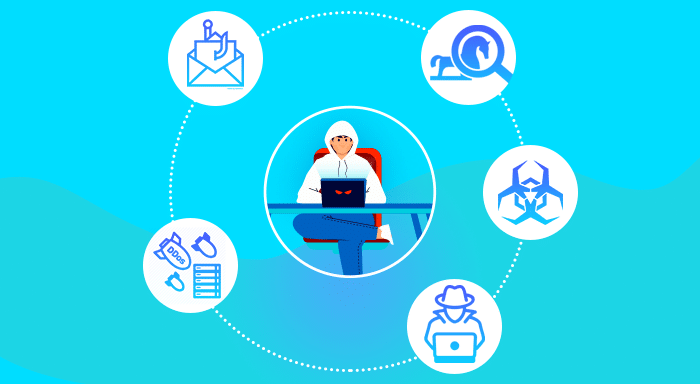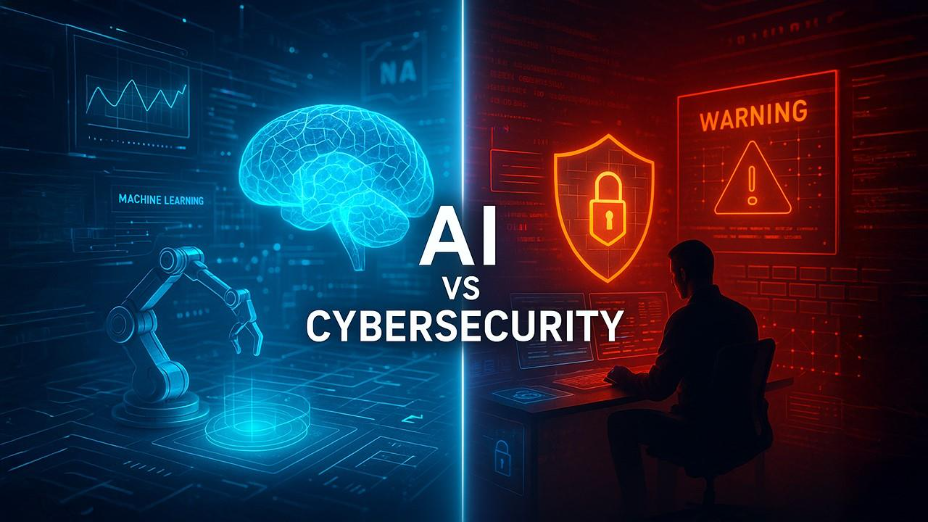Cyber security is the method of protecting computer systems and data from malicious attacks that occur digitally. Most people usually interchangeably use the terms cybersecurity and IT (Information Technology) security like both of these are synonyms. However, this is not valid.
There is a slight difference between both, which led to this confusion. IT security covers broader aspects which include digital as well as analog information, whereas, cyber security majorly focuses on prevention from digital threats.
The main objective of these security measures is to tackle the digital threat either through proactive methods or precautionary ways. These digital threats are more commonly known as “cyberattacks”, which aim to access, modify, damage, or corrupt the existing data of an organization or person.
Annually cyber threats like malware, EMOTET (Advanced Modular Banking Trojan), etc. have cost around $6 Trillion USD in 2021 only. In order to be saved from such devastating cybercrime, you need to be prepared on a personal as well as enterprise level.
The estimated cost not only includes damage and destruction of data but also lost productivity, stolen assets, loot of intellectual property, embezzlement, loss of the reputation of the company, weakened customer trust, and many more. In addition to this, the revival and recovery from cyberattacks also cost significant amounts of money to the company. For example, forensic investigation, deletion of compromised data, federal charges, penalties, and even lawsuits in many cases.
Types of Cyber Security Practices and Methods
Cyber Security is all about creating, combining, and maintaining layers of protection. Below, we have enlisted some counter-practices in the progressive order. These actions should be implemented by every organization, in order to avoid cyber attacks.

Optimal Infrastructure Security
In this step, you need to learn the best practices to shield your all physical as well as digital assets. This includes computer systems, the entire network, physical servers, internal safety, etc. For comprehensive security, consider adopting a holistic XDR protection approach. It unifies threat detection and response across every layer of your environment, including networks, cloud workloads, endpoints, identity and access management, and cloud services, ensuring coordinated protection against evolving cyber threats. For example, if you have an on-premises/physical server then you only need to allow authorized personnel to enter it.
For assistance, you can check out the guidelines issued by the National Institute of Standards and Technology (NIST) and the U.S. Department of Homeland Security (DHS). They have built cybersecurity frameworks for getting the utmost security.
Network Security
As the name suggests, this measure is taken to secure the computer network from unauthorized access, and internal and external breaches as well. No matter what type of connections you have, wired or wireless, proper and effective network management and security should be in place.
Application security
Typically, a business uses many business applications, some of them are installed on-premises while others are on the cloud. Regardless of their server type, you always need to ensure their security. If you have a home-developed solution then you can integrate security features during the designing stage.
Cloud Security
For those who don’t know, there are three main stages of data stored in the cloud. The first is at rest (when data is simply stored on the server), the second is in motion (when data is moving from one location to another like the server to application), and the third is in the processing stage (when information is being processed). In all three stages, you have to make sure of data integrity to provide uncompromising customer service and follow all regulatory compliance norms. One way to ensure your cloud infrastructure is secure is through regular security assessments, such as AWS penetration testing, which helps identify vulnerabilities in your cloud setup and protects sensitive data at all stages. Aligning with NIST cybersecurity framework compliance can further enhance your cloud security by providing a clear structure for assessing and mitigating risks.
In building a robust cybersecurity framework, VPNs remain a critical line of defense. Services like PlanetVPN offer strong encryption, IP masking, and zero-log policies, helping users stay protected from data breaches and surveillance. By securing internet connections and preventing DNS leaks, these tools complement proactive measures like penetration testing—together forming a more resilient shield against modern cyber threats.
Information security
There are several data security rules and regulations like GDPR (General Data Protection Regulation), which is considered one of the toughest data security policies. Similarly, PCI DSS (Payment Card Industry Data Security Standard) safeguards cardholder data to prevent payment card fraud. PCI 6.4.3 is a requirement e-commerce businesses need to follow to stay safe from the threat of JavaScript skimming attacks. It will protect your customer data from breaches and also restrict companies from using client’s information without their consent.
End-user Education
Building your software and infrastructure strong is not enough, you also need to prepare the end-users and employees. For example, you can make employees aware of phishing, how to identify suspicious and speculative emails, etc. Believe it or not, this tactic can save you from a lot of cyberattacks.
Disaster Recovery and Management Policy
There are times when even after implementing all the possible strategies things go South. In such scenarios, IT support services become essential for executing disaster recovery plans, maintaining updated backups, and ensuring swift business continuity. Apart from cyber threats, there are other major possibilities as well like power outages, natural disasters, etc. So always be prepared and have a solid and updated database backup all the time.
Common Cyber Security threats to consider while creating the strategy
Cybercriminals always keep on finding new ways to exploit the weaknesses in the defense mechanisms of the system. It may sound surprising but most of the time the organization didn’t even know they were attacked. Especially, in the current work-from-home scenario where everyone has remote access. This is making digital security more vulnerable than ever before. Check out the types of cyber threats commonly used by attackers.

Malware
This type of threat is quite famous and has cost millions of dollars to organizations. It has various versions like worms, viruses, trojans, spyware, and ransomware. When users click on the link or attachment that comes via malware, they unknowingly provide unauthorized access to the attacker. Nowadays, malware has grown advanced and become fileless, which allows them to go around firewalls and anti-virus without any detection. Reliable firewalls can offer solid defenses against such attacks. Organizations can implement a firewall policy analyzer to pinpoint a misconfiguration and correct it before something goes wrong.
EMOTET
This botnet/malware was first discovered in 2014 and it was primarily a banking malware that compromises the system security and steals sensitive & confidential information. The Cybersecurity and Infrastructure Security Agency (CISA) has been considered one of the most dangerous trojans. Now you must be thinking about what makes it different and destructive than others. Allow us to explain how it attacks your system and prevents itself from getting detected by firewalls and anti-viruses.
Emotet is a malware that is primarily spread through spam emails. The emails may contain malicious attachments, such as Word documents Excel spreadsheets, or links to malicious websites. When the recipient opens the attachment or clicks on the link, the malware is downloaded and installed on the victim's computer.
Once Emotet is installed, it can do a variety of things, including:
- Stealing personal information, such as passwords, credit card numbers, and bank account information.
- Distributing other malware, such as ransomware and banking trojans.
- They are taking control of the victim's computer and using it to send spam emails or launch other attacks.
Emotet is a very sophisticated piece of malware that is constantly being updated to evade detection. It is one of the most dangerous malware threats today.
Phishing / social engineering
Phishing is one of the most common types of social engineering. For those who don’t know, social engineering is a manipulation technique, which is used by attackers to extract the confidential information of users. Phishing attacks involve fake communications like emails, fraudulent calls, etc.
Distributed Denial of Service / DDoS Attacks
A DDoS is a malicious attack on the server or website. The main objective of this is to slow down or temporarily shut down the website by sudden overwhelming traffic. These attacks are difficult to differentiate because they are carried out by internet-connected machines with different IP addresses.
Each computer is already infected with malware and can be controlled remotely. The single computer system is called a bot or botnet. Once an army of bots is built, the attacker directs them to the targeted server. This sudden spike in traffic leads to overcharging on the server, which results in denial-of-service (DoS) to the normal and genuine server.
Man in the Middle Attacks
The Man in the Middle technique is adopted by an attacker to invade the two-way conversation which is supposed to be encrypted. After intercepting the conversation, cybercriminals can get their hands on sensitive information.
Most of the time, neither the victim nor the entity with which the victim is interacting has any idea about the attack. This type of cyber security attack occurs on the public/unsecured Wi-Fi network. Some common types of MITM attacks are SSL Hijacking, Email Hijacking, Wi-Fi eavesdropping, and theft of browser cookies.
The fortunate thing is that cybersecurity technologies have also developed over the years. Nowadays, it is not that easy to break into anyone's system and steal data. Solutions like cyber risk remediation software offer an in-depth insight into the prevailing threats, and help in prioritizing the ones that actually matter. If you also want to learn more about cyber security best practices then read this article further.
How Digital Access Impacts Various Areas Of Cybersecurity?
Let me ask you a question, right now where you have stored most of your property and assets? Talking about money in your bank or your investment in cryptocurrency and stocks, nearly all things are digital. It’s not only limited to individuals but big firms from various industries like healthcare, financial services, etc. store their data digitally.
For example,
- Cyber security of Internet of Things (IoT) devices: The main function of any kind of IoT device is to store and process user data. Cyberattacks are specifically designed to target IoT devices that are connected to a network.
The Best Cyber Security technology to tackle such threats
If you want to be less vulnerable against cyber-attacks and would like to strengthen your cyber security then here is something you could do. Context-aware behavioral Analytics is a programming algorithm that can help you out with the same.
Think of this as a computer program that keeps track of all the activities that you perform on a platform. Big tech companies and firms like Facebook, Instagram, and other major social media platforms are utilizing this cybersecurity technology. Till now, it has been one of the most effective actions against cyber attacks.
These programming systems are designed in such a way that they monitor what a user usually likes or doesn't like, actions that a user takes typically through its account. After analyzing the day-to-day activities, the program senses if there are any abnormal activities or even potential threats.
Another emerging technology that is quite efficiently neutralizing cyberattacks is Blockchain. For those, who don't know Blockchain is a decentralized form of database that is practically impossible to hack or alter. If you want to learn more about it then head out to our blog on Blockchain. Here we have discussed how it works and why it is the safest type of database.



